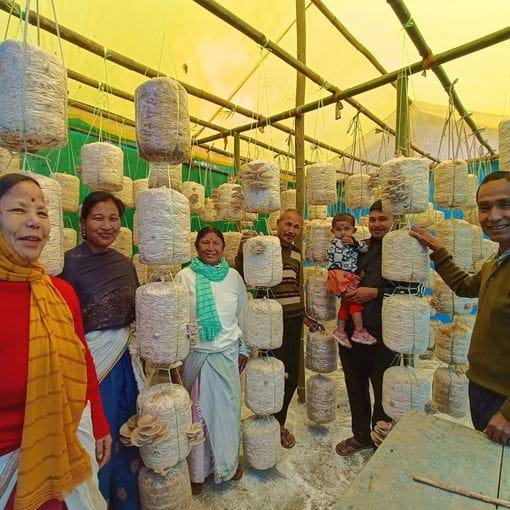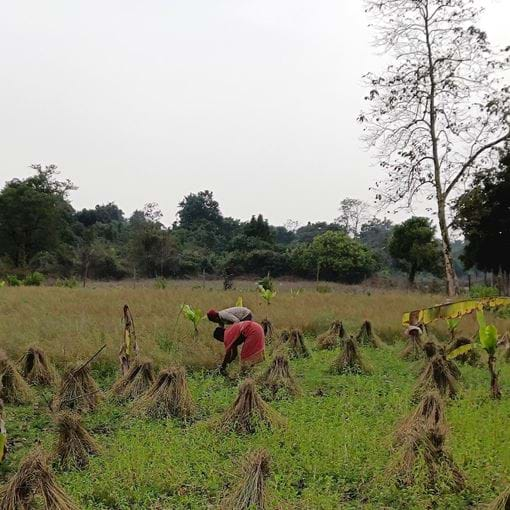An Appetite for Coexistence: Four Alternative Crops to Manage Human-Elephant Conflict
When the kids know where the snack drawer is, your snacks aren’t going to last very long.
Elephants aren’t children, but they are hungry. A push-pull effect draws elephants into human settlements – habitat degradation pushes herds out, and the nutrient/calorie rich agricultural crops pull them in. A common cause for human-elephant conflict (HEC) is when elephants either consume or flatten enough crops that a family is out of a year’s supply of food.
That’s where our partner, Aaranyak, have come in to identify crops that elephants tend to avoid, and bring in enough earnings to help mitigate HEC losses.
1) Spawning mushroom businesses across the landscape
Over the last few years, the demand for mushrooms has grown in Indiai. In Assam, where mushrooms have always been popular, the increased demand has meant that farmers can recoup losses from HEC, and then some, as mushrooms are not on the menu for hungry elephants.
With our partner’s help, the Gogoi brothers have restarted their business and turned a profit through cultivating mushrooms.
“Mushrooms are easy,” said Mridul Gogoi. The cultivation is not labour intensive, especially in the Gogoi household where everyone pitches in The profits are then reinvested into their farm, improving their quality of life.

2) Not quite small potatoes
Potatoes are among the most widely cultivated vegetables in Assam. And while elephants do eat roots and tubers, the elephant herds in this region have not discovered these potatoes yet.
“The potatoes we farm – everyone talks about how they are really good quality, very excellent,” said Ranjani Suna.
Farmers like Ranjani don’t have a lot of losses thanks to the disease-resistant strain of potatoes that our project has identified for cultivation. They’re able to sell most of their harvest in the market, which is a great profit from a field that took two people only a day to plant.

3) Zesty fencing with Assam’s state fruit
Elephants have an incredibly strong sense of smell, which is probably why they dislike anything citrusyii. But the Assamese people love their sour curries and biting into a wedge of the delightfully refreshing Assamese lemon during a meal.
The fruit is so dear to the state that the government declared the lemon, known locally as the Kaji nemu, to be the state fruit of Assam. It only makes sense that people would use it as much as they can, including planting it as a bio fence to keep elephants out.
The trees grow quickly and fruit readily, producing nearly 40-50 fruits per treeiii. The aromatic fruits repel elephants, who are all too happy to skirt around the sharply smelling Kaji nemu and its thorny branches. In addition to fencing, the trees also offer an additional source of income to communities to mitigate losses from HEC.
4) (Don’t) hold the mustard
Just a year ago, an elephant herd raided the paddy farmed by Uttam and Kohinoor Gogoi. When our support team offered an opportunity to shift to alternative livelihoods that would make up for the losses, the pair decided to cultivate mustard, a crop they knew well.
As subsistence farmers, Uttam and Kohinoor Gogoi cultivate just enough mustard for their personal use in the form of seeds and edible oils, but sometimes they have a surplus.
“It’s a cash crop, mustard, so they can use it as a fixed deposit,” explained Dr Alolika Sinha, a senior wildlife biologist at the Elephant Research and Conservation Division of Aaranyak. When there’s a surplus, or when they need ready cash, the farmers sell the mustard in the wider market.

Identifying crops that work for people
Despite what aesthetically filmed cottage core videos tell you, farming isn’t easy, and each crop is different. We work closely with the community to identified which crops will work best for them.
Our partners then offer materials as well as training and information about market requirements to upskill our communities.
Not all avenues have been successful. But close monitoring and adaptation to alternative livelihoods that work for people (and not for elephants) have helped reduce instances of HEC.
Having alternative livelihoods also builds tolerance. It is much easier to live with elephants when you know that your livelihood isn’t at stake.
To learn more about our work in Assam and other emerging HEC hotspots in North-East India, click here.
By Caroline Abraham, Communications Officer - Conservation
-
[iii] https://kiran.nic.in/pdf/Agri-Kaleidoscope/Horticulture-resources/ASSAM_LEMON.pdf
